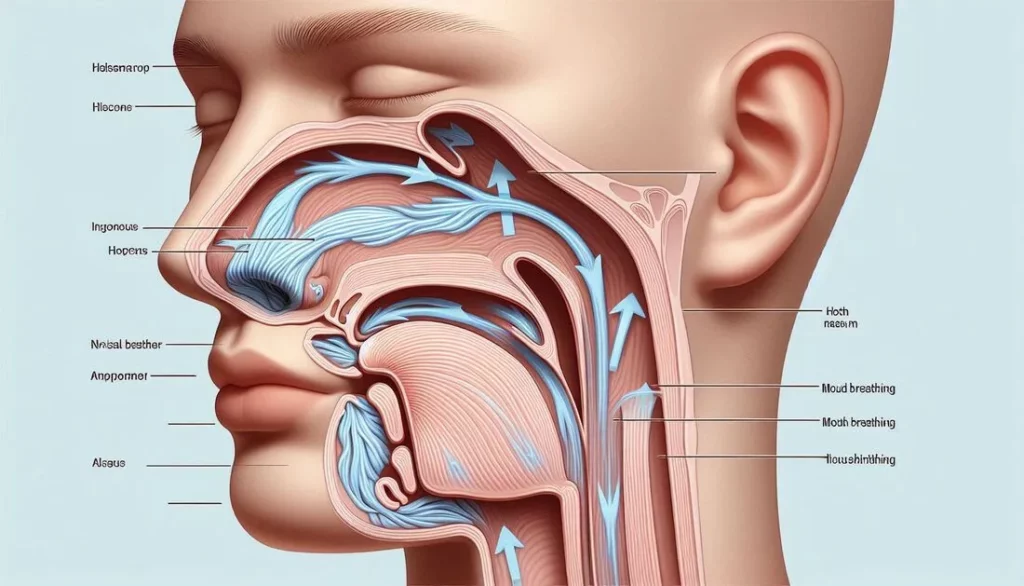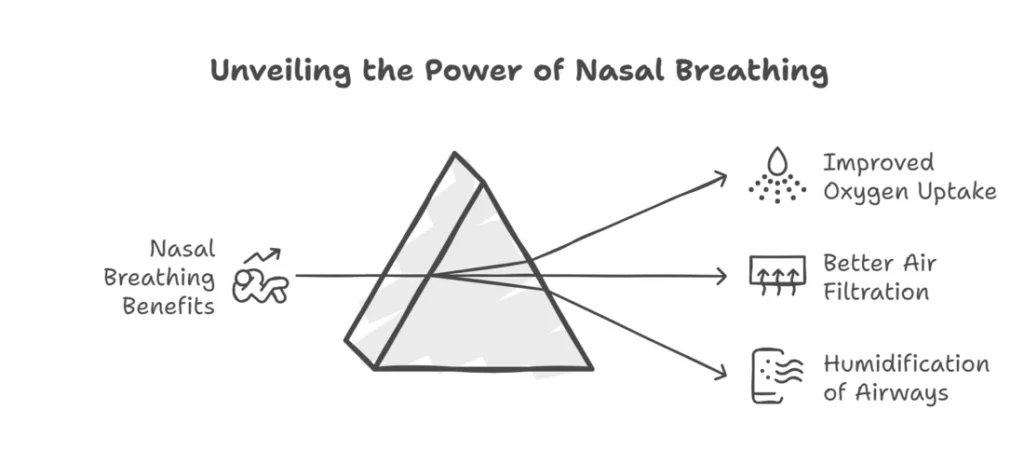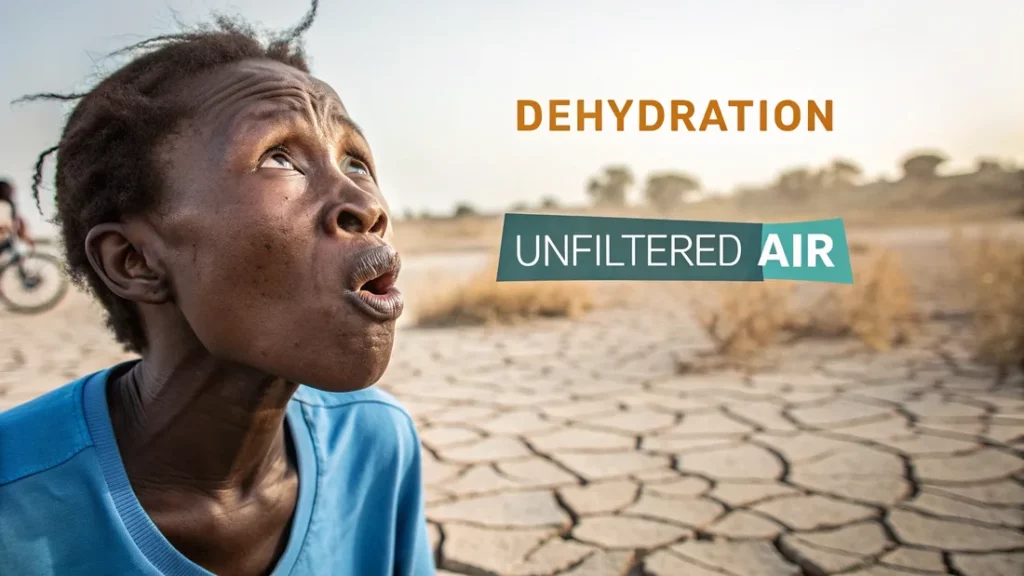Have you ever paused during a workout, gasping for air, and wondered if you should be breathing through your nose or your mouth?
While it might seem like a simple, instinctive act, the way you breathe during exercise can make a massive difference to your overall performance, your stamina, your energy levels, and even your recovery.
The debate between nasal vs. mouth breathing during workouts has been a hot topic amongst athletes, fitness enthusiasts and healthcare professionals for many years.

With so many different viewpoints, it can be difficult to know which method is the correct one.
In this post, we’re going to explore the core differences between these two methods, and also uncover which method is best for optimizing your athletic performance, and why.
Get ready to learn everything you need to know to take control of your breath, and to also take control of your workouts!
Nasal Breathing vs. Mouth Breathing – What’s the Difference?
To understand which breathing method is best for workouts, it’s crucial to first explore the fundamental differences between nasal and mouth breathing.
While both methods deliver air to your lungs, they engage different physiological processes, and they can also have a different effect on your body.

Key Differences
- Nasal Breathing:
- Nasal breathing involves inhaling air through your nose, which is the body’s natural method of breathing. This process allows the air to pass through your nasal passages, which have many unique properties.
- By using your nose to breathe, you are also taking advantage of your body’s natural systems that are there to protect your airways and optimize your breath.
- Mouth Breathing:
- Mouth breathing involves inhaling air through your mouth, bypassing your nasal passages. Although this allows for unrestricted airflow, it lacks the important filtering and humidification processes offered by nasal breathing.
- When you breathe through your mouth, your body is less efficient as it bypasses these important processes that are necessary for a healthy and optimal breath.
- Physiological Differences:
- There are several key physiological differences that occur when using either your nose or your mouth to breathe. Firstly, when you breathe through your nose, your nasal cavity helps to filter any impurities and also to humidify the air, before it enters your lungs. Secondly, your nasal passage is designed to release nitric oxide, which aids in oxygen absorption and improves circulation throughout the body.
- These processes do not happen with mouth breathing, making it a less efficient method for delivering oxygen.
Read More
Title: “Nasal nitric oxide flux from the paranasal sinuses“
This is a study published in a reputable source (the National Institutes of Health), which highlights the role of the nasal cavity in producing nitric oxide.
Why Nasal Breathing is Beneficial for Workouts
Now that you have a clear understanding of the differences between nasal and mouth breathing, let’s explore the specific benefits that nasal breathing can provide during workouts.
While it might seem small, focusing on using your nose to breathe can have a big impact on your athletic performance.

Key Benefits
- Improved Oxygen Uptake:
- When you breathe through your nose, you are making the most of your body’s nitric oxide production process. This powerful molecule helps to dilate blood vessels, which results in more efficient oxygen delivery to your muscles, and a more effective workout overall.
- This has a direct correlation to how your body performs, and how you are able to push yourself during exercise, and also reduces feelings of fatigue.
- Better Air Filtration:
- Your nasal passages contain tiny hairs and also a mucous membrane that help to filter out any impurities, allergens, and other pollutants. This ensures that your body is receiving clean air, which will also help to reduce irritation in the lungs and airways.
- By filtering your air, you are reducing the amount of debris and pollutants that enter your body, which will also improve your overall health.
- Humidification of Airways:
- As you breathe through your nose, your body will warm and humidify the air that is passing through your nasal passages. This helps to moisturize and protect your airways, which can be especially beneficial for athletes performing in cold, dry conditions.
- By ensuring your air is humidified, you will also prevent irritation and also promote more efficient oxygen intake. This will also reduce feelings of fatigue and breathlessness during strenuous exercise.
The Potential Downsides of Mouth Breathing During Exercise
While mouth breathing may feel like a natural response during intense exercise, it’s important to understand that it can also come with several downsides, which can ultimately impact your overall performance and well-being.
Let’s delve into why mouth breathing during workouts should be something to be avoided, or to be minimized.

Potential Downsides
- Reduced Nitric Oxide Production:
- When you breathe through your mouth, you bypass your nasal passages, which are the main area of production for nitric oxide. This important molecule plays a key role in blood vessel dilation and oxygen delivery. Therefore, when you breathe through your mouth, you are reducing the amount of nitric oxide you produce which can lead to a less efficient breathing process, and less oxygen reaching your muscles.
- This also reduces your ability to use your breathing as a tool for performance.
- Dry Mouth and Airways:
- Mouth breathing during exercise can often lead to a dry mouth and dry airways, which will not only cause discomfort, but also hinder your overall performance. Without proper humidification, your airways can become irritated, and also may lead to a feeling of dehydration and also discomfort.
- It is important to keep your airways as moist as possible when performing any exercise to ensure you are getting the most out of your breathing.
- Increased Airway Infections:
- By bypassing the nasal passages when mouth breathing, you are also reducing your body’s ability to filter out any harmful substances in the air, such as bacteria, allergens, and pollutants. This can lead to an increase in airway infections, and also a reduction in your overall health.
- By ensuring that you are breathing through your nose, you are protecting your airways, and your lungs, and reducing the risks of any unnecessary irritation.
Read More
Title: “Adverse Health Effects of Mouth Breathing: A Review“
This article published by a reputable source (National Institutes of Health) discusses the negative effects of mouth breathing and has many credible citations to explore further.
Tips For Practicing Nasal Breathing During Workouts
Embarking on a journey to adopt nasal breathing during workouts may feel challenging at first, but with a little know-how, it can soon become second nature.
Here are some practical tips that will help you make the transition smoother, while also keeping your overall health in mind.
Key Tips
- Start Slowly:
- As you start your journey with nasal breathing, make sure you are taking a slow and steady approach. Do not push yourself to breathe through your nose during every workout, simply focus on implementing it where it is practical for you. This approach will help you to more easily make nasal breathing a part of your workout routine.
- Remember, that the aim is not perfection but progress, so it is best to approach it with a mindful and measured approach.
- Lower Intensity:
- When you start focusing on your breathing, you may need to temporarily reduce the intensity of your workouts. This will help you to focus on implementing the method correctly, rather than pushing yourself too hard. Be patient, and be sure that you are listening to your body at all times.
- As you get more confident and comfortable with nasal breathing, you can then gradually increase the intensity of your workouts, as your lungs adapt to this method.
- Practice Regularly:
- Consistency is the key to success when trying to implement new breathing methods. Try to implement nasal breathing in a few of your workouts, and then gradually integrate it into all of them.
- By doing it regularly, it will become a natural part of your workout journey, and will also help to improve your overall performance and fitness.
- Monitor your Progress:
- As you get used to nasal breathing, it is important that you pay attention to how you feel, and track your progress. By monitoring your progress, you will be able to see whether this method is working for you. You should also note how you feel before and after your workouts to monitor your overall progress.
- By tracking your results, you will also be able to understand the effectiveness of the method and make changes to best suit your individual needs and goals.
Frequently Asked Questions About Nasal and Mouth Breathing
To ensure you have a clear understanding of when and how to use nasal or mouth breathing, let’s address some of the most common questions that people have.
These questions have come from reliable sources that target users who are seeking answers on the topic of breathing and performance.
- Question 1: Should you breathe through your nose or mouth while exercising?
- Answer: While it may seem simple, there is a clear answer. You should strive to breathe through your nose during all types of workouts. Nasal breathing offers many benefits that cannot be achieved by mouth breathing. While it may feel more comfortable to breathe through your mouth, the benefits of nasal breathing are significant, and should be taken into consideration for a more well-rounded and healthy approach to fitness.
- Question 2: Is it okay to breathe through your mouth during hard exercise?
- Answer: While mouth breathing should generally be avoided, it is understandable that some individuals may need to switch to mouth breathing during very high intensity workouts, or when you are pushing yourself to the limit. However, it is always best to go back to nasal breathing when you can, and to make nasal breathing the main part of your workout. If you struggle with nasal breathing during workouts, start slowly and lower the intensity to allow your body to adjust to the new method.
- Question 3: What are the benefits of nose breathing while exercising?
- Answer: Breathing through your nose allows your body to more effectively deliver oxygen to your muscles, which will help to reduce fatigue, improve your overall performance, and also help to protect your lungs. The nasal passages are also important for filtering out any bacteria, pollutants and allergens, which ensures that your lungs remain healthy, and ready to perform at their best. These are all important reasons why nasal breathing should be your first point of call when working out.
- Question 4: When is mouth breathing okay?
- Answer: While you should always try to maintain nasal breathing during your workouts, there are some specific scenarios where it is acceptable to breathe through your mouth. If you are doing very high intensity exercise, or you are pushing yourself to your limits, it may be more natural to start mouth breathing, however you should always strive to return to nasal breathing as soon as you can. It is also acceptable to mouth breath during cool downs.
My Final Thoughts on Nasal vs. Mouth Breathing
As we come to the end of this discussion on nasal vs. mouth breathing, I hope that you now have a clearer understanding of which method is best for your workouts.
We have explored the core differences between these two methods, and also highlighted the many benefits of nasal breathing.
While it may be tempting to breathe through your mouth during intense exercise, it is important to remember that this method is less effective than nasal breathing, as it does not provide all the same benefits.
Nasal breathing is far more beneficial to your overall performance and well-being, and by making a conscious effort to implement this method, you will be on the path to a healthier, more mindful and more effective workout routine.
I urge you to start experimenting with your breathing today, and to see just how much of a difference nasal breathing can make to your workouts.
The key is consistency, and remember to be patient with yourself, as you start on this new journey.
By implementing mindful nasal breathing into your daily routine, you are setting yourself up for a more positive and fulfilling workout experience.
Now, go forth and breathe!
Related Posts
No posts
